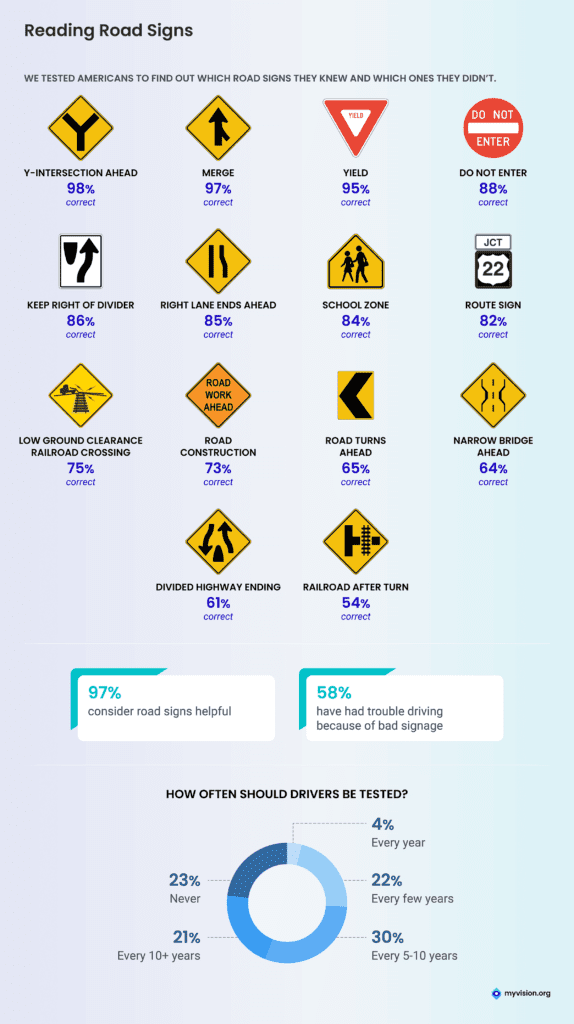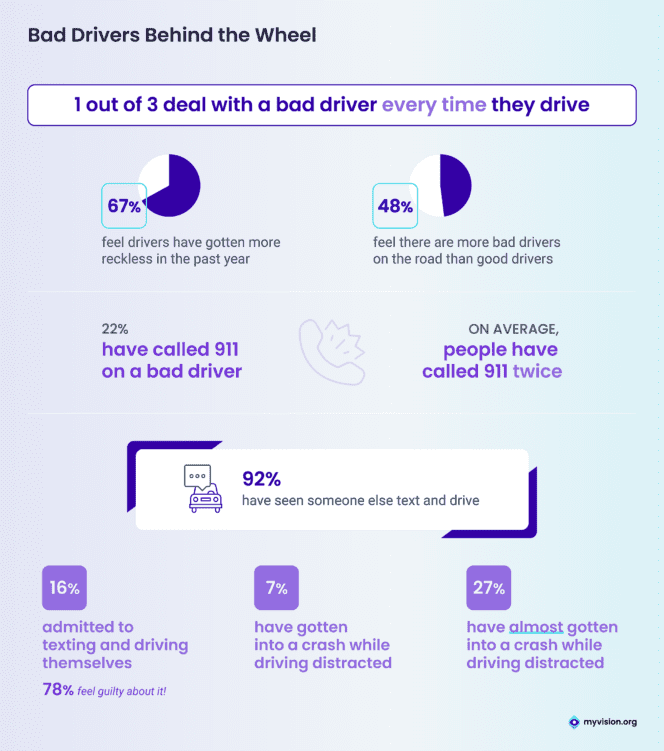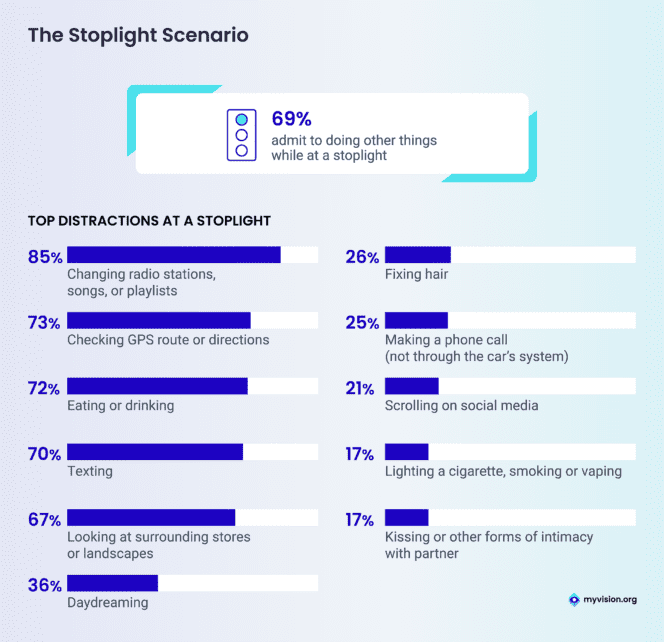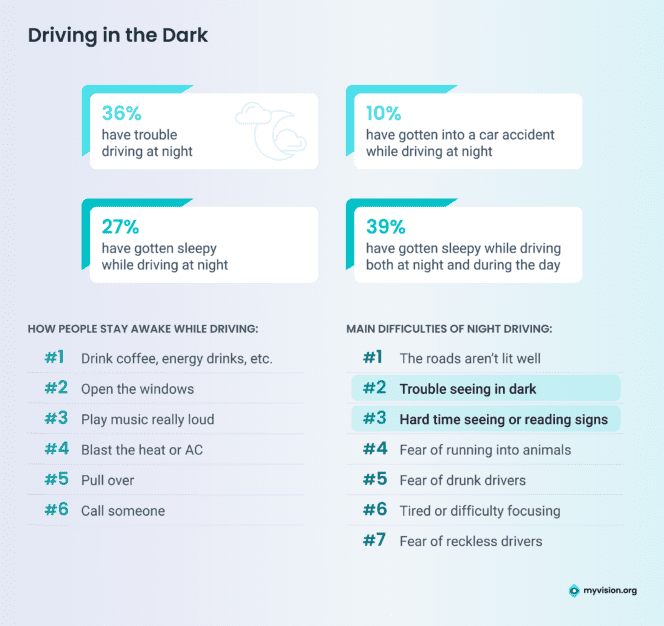There is so much to figure out when you start learning how to drive. Do you know where the mirrors are around your car? How about the rules of the road? Can you identify all those road signs? A lot of it seems like common sense, but after initially learning and passing driver’s education courses, drivers don’t always get tested regularly.
We surveyed more than 1,060 drivers about road signs and other distractions they face while they’re behind the wheel. Most drivers surveyed have had their license for an average of 25 years, but that doesn’t necessarily mean they can identify all the road signs!
Recognizing Road Signs

We tested drivers in two different ways. One, by showing some federally-approved signs with just their shapes and colors (no text), which is the way some tests are given at local DMVs. We did this with the yield, do not enter, school zone, and road construction sign. The main sign people had trouble identifying was the road construction sign. Nearly 13% confused it for a railroad crossing sign, 4% mistook it for a slow-moving vehicle sign, and 4% thought it was a no-passing sign.
Second, we showed drivers other signs (with text) and asked them to identify what it signified. The most identified road signs were some of the more common ones. Nearly 100% of drivers could pinpoint the merge sign. Only about 1 out of 10 had trouble with signs like the right lane ends ahead.
Trickier signs like the divided highway ending and railroad after turn were the ones that tripped up drivers the most. About 2 out of 5 did not know what these signs meant.
Overall, 97% feel road signs are helpful. The biggest issue drivers run into is when signs aren’t placed well. Nearly 60% report trouble driving because of bad signage.
Drivers are torn about how often people should take driver’s tests. Nearly 1 out of 4 think drivers should never be tested after the initial test getting their license, but more than half feel drivers should be tested about every 5-10 years.
Dealing with Bad Drivers

Even when drivers know all the rules of the road, it doesn’t protect them from other drivers who don’t or just blatantly disregard rules. More than 3 out of 5 (67%) feel drivers have gotten more reckless in the past year. 1 out of 3 (33%) say they deal with a bad driver every time they hit the road, and 39% admit they have run-ins with bad drivers at least once a week!
More than 1 out of 5 (22%) have resorted to calling 911 on a bad driver. On average, people have called the police twice about scary situations on the road.
Astoundingly, 92% have seen someone else texting while driving, but only 16% of respondents admitted to texting and driving themselves. Of those people, 78% said they feel guilty about doing it. Less than 1 out of 10 (7%) have gotten into a crash while driving distracted, but 27% have almost gotten into a crash while driving distracted.
Stoplight Distractions

Nearly 7 out of 10 admit they do other things at a stoplight rather than pay attention to the road. The top distractions are changing the music (85%) or looking at the GPS (73%).
However, while only 16% admitted to actively texting while driving, 70% say they pick up their phone and text while stopped at a stoplight! Another 1 in 4 said they make phone calls (not through the hands-free option), and 21% aimlessly scroll on social media.
A bold 1 in 5 (17%) admit to kissing or other forms of intimacy while at a stoplight and/or smoking a cigarette or vaping while in the driver’s seat.
Night Driving

Driving in the dark is a struggle for many drivers. More than 1 in 3 (36%) have trouble driving after the sun sets, and 10% have gotten into a car accident at night. The main issue drivers face is that the roads aren’t well lit, the drivers themselves have trouble seeing in the dark, and drivers have a hard time reading road signs!
Drowsy driving is a common issue many people face. Nearly 3 out of 10 (27%) have gotten sleepy while driving at night, and almost 40% admit to getting sleepy while driving both at night and during the day.
If drivers start having trouble staying awake, many resort to drinking coffee or energy drinks, opening windows, and playing music really loud. Nearly 40% decide it’s best to pull over.
Methodology
In July 2022, we surveyed 1,062 people to get their feedback about driving and road signs. Respondents ranged in age from 18 to 84 with an average age of 41. 49% were female, 49% male, and 2% transgender. On average, respondents have held a driver’s license for 25 years.
For media inquiries, please contact media@digitalthirdcoast.net.
Fair Use
When using this data and research, please attribute it by linking to this study and citing myvision.org.
Last Updated August 9, 2022
Note: This page should not serve as a substitute for professional medical advice from a doctor or specialist. Please review our about page for more information.